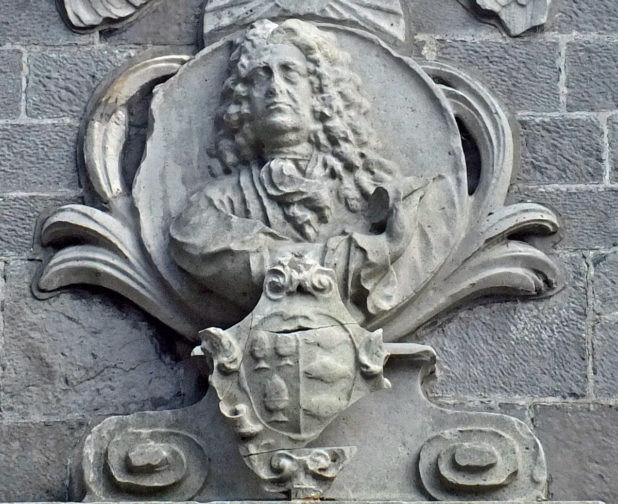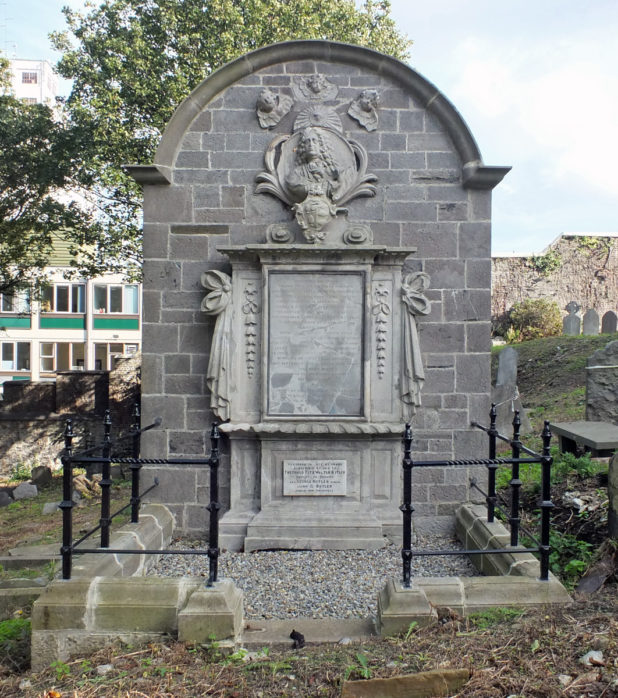Sir Toby Butler – In this article, Historian Sean J Murphy explains the life of Solicitor General of Ireland, SIr Toby Butler who is interred in St James Graveyard, a fascinating slice of history!
Sean J Murphy
The old Protestant St James’s Church and Graveyard in James’s Street have undergone a remarkable transformation in recent years. The church has been restored and converted into the Pearse Lyons Distillery, while the graveyard is also undergoing restoration by its current owners Dublin City Council, with the promise that when work is finished it will be open to the public.
Reflecting the divisions which followed the Reformation in the sixteenth century, St James’s Parish had two churches dedicated to the saint, one Protestant and the other Catholic, the latter still in religious use in James’s Street. Because of religious discrimination, Catholics were not allowed their own graveyards and had to share the Protestant ones in Dublin city. Hence the fact that Catholics continued to be buried in the Protestant St James’s Graveyard until the late twentieth century, and indeed a majority of those buried there are Catholics.
The most remarkable monument in St James’s Graveyard, which features a bust of the deceased and a Latin inscription, marks the burial place of Sir Theobald or Toby Butler. Toby Butler was born about 1650, the son of James Butler of Boytonrath, County Tipperary, and Mary Butler of Kilmoyler in the same county. Toby’s kin were Catholics and belonged to the Dunboyne branch of the Butlers, one of the leading Norman families in Ireland. Toby Butler trained as a lawyer in London and Dublin and following the accession of the Catholic King James II, he was knighted and appointed Solicitor General for Ireland in 1689.
After the defeat of James II at the Battle of the Boyne in 1690 and his replacement as monarch by the Protestant William of Orange, Sir Toby Butler was closely involved in negotiating the Treaty of Limerick in 1691 on behalf of the losing side. Under this treaty the Irish surrendered to William on condition of being guaranteed rights of worship and some other freedoms. These concessions would unfortunately be largely disregarded by the triumphant Protestant ‘Ascendancy’ and a series of Penal Laws would be passed limiting the political, religious, employment and property rights of Catholics. While Catholics were prevented from qualifying as lawyers under the Penal Laws, established Catholic lawyers, including Sir Toby, were allowed to continue in practice.
Many humorous anecdotes have been passed down concerning Sir Toby, who as well as being a very able lawyer was obviously something of a wit also. Sir Toby reputedly liked his claret, and once when obliged to promise that he would not drink before appearing in court, he circumvented this by eating bread soaked in liquor. On another occasion in court a judge, who did not himself have the best reputation, criticised Sir Toby for not having clean ruffles on his sleeves, to which the lawyer responded cuttingly, ‘That may be, but your Lordship will notice my hands are clean’.
Butler specialised in defending the rights of the diminishing number of Catholic landowners during the Penal era, when the law was stacked in favour of Protestants and indeed was designed to dispossess Catholics. In 1704 Sir Toby and other Catholic lawyers were allowed to make an appeal in the Irish House of Commons against harsh anti-Catholic legislation then in progress, but the laws passed nonetheless. While Sir Toby used his legal knowledge to protect his own property rights as far as he could, his final days were not as comfortable as they had been in the time of James II. Toby Butler married Margaret Roche, with whom he had five sons, James, Theobald, John, Jordan and Henry, and at least one daughter, Frances. Butler died on 11 March 1721 and was buried in St James’s Graveyard, a favourite burial place of Dublin Catholics both rich and poor during the Penal era.
Butler’s grand monument, about 5.5 metres high and 3.5 metres wide, is located in the centre of St James’s Graveyard and is one of Ireland’s most prominent memorials to a Jacobite, as supporters of James II were known (from the Latin for James, ‘Jacobus’). As well as a bust of Sir Toby (the only image of the man known to the writer), the monument also features a plaque with the arms of Butler and Roche, ‘impaled’ or combined. The monument was erected by Sir Toby’s eldest son, James Butler, and he and other family members are buried in the adjoining tomb. The Latin inscription on Sir Toby’s tomb praises his character, notes that he excelled in ‘the legal and his native dialect’ and concludes with the pointed observation that ‘were it not for his religion’, his fortune might have equalled his fame.
The Butler monument has been repaired several times, in 1876 by Augustine Butler of Ballyline, County Clare, in 1972 by several members of the Butler family and most recently between 2014 and 2019 by stonework experts commissioned by Dublin City Council. Given the amount of decay and damage suffered by the tomb in recent decades, the restoration work is impressive.
Sir Toby Butler’s year of death is sometimes given as 1720, but this represents the ‘Old Style’ dating of the Julian calendar which was replaced by the Gregorian calendar in 1752. Thus it is more correct to use the ‘New Style’ dating and record that Sir Toby died in 1721. This means that next 11 March 2021 will mark the 300th anniversary of Sir Toby’s death, and it can be anticipated that this might see some sort of ceremony at his grave in St James’s Graveyard, accompanied perhaps by a seminar on his life and times.
For further articles by the writer on the history of St James’s Church and Graveyard, see https://ucd.academia.edu/SeanMurphy.










